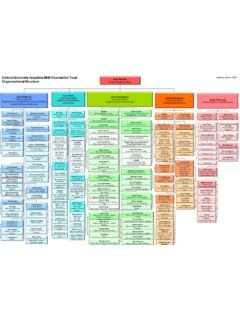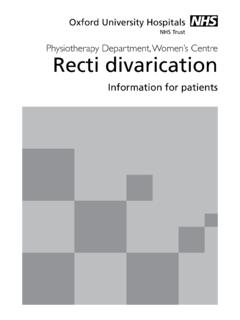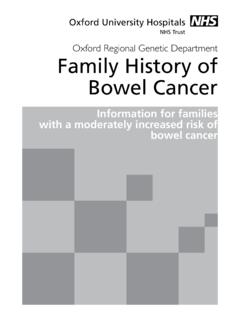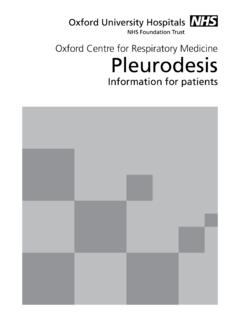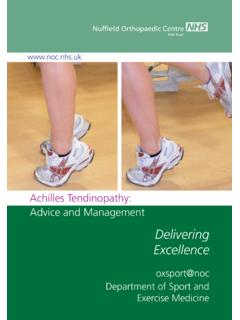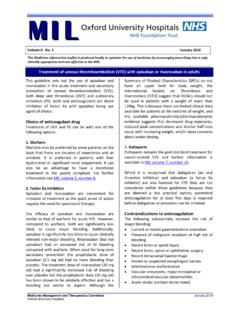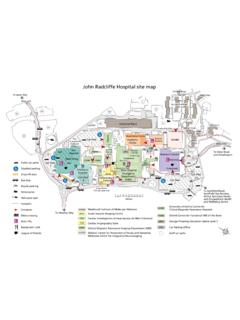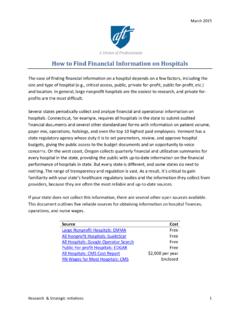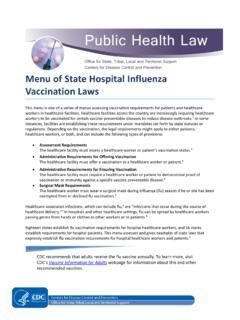Transcription of Oxford University Hospitals - ouh.nhs.uk
1 Oxford University Hospitals NHS Trust Electronic Patient Record benefits case study Oxford University Hospitals NHS Trust Electronic Patient Record (EPR) Benefits realisation case study (Qualifying text in 21pt Arial Bold). 1. Oxford University Hospitals NHS Trust Electronic Patient Record benefits case study HSCIC are the trusted national provider of high-quality information, data and IT systems for health and social care. @hscic This report may be of interest to patients, members of the public, clinicians, staff and other stakeholders involved in the use and benefits of an electronic patient record. Author: Clare Cape, Benefits team, Provider Support Directorate, Health and Social Care Information Centre Version: Date of publication: XX Month 2014. 2. Oxford University Hospitals NHS Trust Electronic Patient Record benefits case study Acknowledgements Oxford University Hospitals NHS Trust (OUH) welcomed the opportunity for this case study.
2 The openness of clinical and front-line staff, and the support provided by the EPR Senior Project Manager to the HSCIC team deserves particular appreciation. List of reviewers Oxford University Hospitals NHS Trust Dr Paul Altmann, Chief Clinical Information Officer, Consultant Nephrologist Andrew Stevens, Director of Planning and Information John Skinner, Director of Information Management and Technology Services Sara Randall, Deputy Director of Clinical Services Bill Renwick, EPR Senior Programme Manager Bryan d'Arcy, EPR Senior Project Manager Eilidh Robbins, Press and Communications Manager Health and Social Care Information Centre Tom Denwood, National Provider Support Director Sarah Jackson, Programme Head, Benefits James Hussey, Benefits Delivery Programme Manager Chelsea Drake, Communications and Engagement Manager Cerner Aiden Malone, Senior Director, European Consulting Emma West, Strategist BT Health Chris Leebetter, Client Director.
3 BT. Steve Charles, Client Service Delivery Director 3. Oxford University Hospitals NHS Trust Electronic Patient Record benefits case study 4. Oxford University Hospitals NHS Trust Electronic Patient Record benefits case study Contents 1. Introduction 8. 2. Executive summary 8. Replacement of obsolete and/or expensive to maintain legacy systems 10. Compliance with programmes such as Choose and Book Direct Booking, and enabling use of NHS number. 10. Foundations for a solid information technology platform in preparation for the Foundation Trust status 11. A system which can deliver a single patient record, supporting clinical decision making 11. Reduced risk of errors arising from having multiple systems by consolidating information in one place and reporting 11. Clinical Notes will be contained in one solution, enabling a single point of identification for all systems, and available at any point of access 12.
4 Ability to record and access patient allergy and alert information electronically at appropriate points in the patient journey 12. Improved audit trail facilities from clinical and information governance perspectives 12. Key benefits associated with efficiency and effectiveness such as: 13. Potential to realise efficiencies in clinical decision making associated with length of stay and clinic utilisation 13. 3. Background 14. Oxford University Hospitals NHS Trust 14. Four Hospitals , one trust, one vision 14. OUH Strategic Objectives 16. OUH Digital Vision 17. Key indicators 17. BT Local Service Provider (LSP) contract 18. Health and Social Care Information Centre 19. 4. HSCIC benefits case study at OUH: approach and scope 19. Objectives of the case study 19. Scope of the case study 20. Approach and methodology 20.
5 5. Organisation wide findings 21. Engagement and buy in 21. Level of adoption 23. Cost Improvement programme (CIP), transformation and implementing the EPR 28. 6. Benefits identified by specialty / pathway 29. New functionality deployed during case study 29. 5. Oxford University Hospitals NHS Trust Electronic Patient Record benefits case study Electronic prescribing and medicines administration (ePMA) implementation 29. Emergency Department single encounter (EDSE) 42. Blood products 44. INet (neurosciences intensive care) 49. Back-up system for downtime 724 Access 51. Patient administration and management 51. Recording admission on EPR: 51. Medical records 52. Respiratory service bronchoscopy preparation 54. Beds and flow 55. Referral to treatment pathway 55. Data reporting via data warehouse and OUH Reporting Business Intelligence Tool (ORBIT) 56.
6 Outpatient letters 56. Maternity pathway 56. Service context and provision 57. Use of EPR 57. Opportunities 58. Orthopaedic pathway 58. Urgent care medicine pathway 60. Urgent care surgery pathway 61. Theatres 61. Therapies 63. 7. Delivering effective care 65. Patient safety 65. Clinical governance; audit; incidents 67. Clinical coding 67. 8. Benefits management evaluation and digital maturity 67. HSCIC evaluating benefits 68. Evaluating benefits in the LSP cohort of healthcare organisations in south of England and London 70. Clinical Digital Maturity Index 71. Health Information and Management Systems Society (HIMSS) analytics 72. 9. Conclusions 73. 10. Recommendations 75. 6. Oxford University Hospitals NHS Trust Electronic Patient Record benefits case study 11. Index of figures 77. 12. Appendices 79.
7 Appendix 1: Glossary of Acronyms 79. Appendix 2: Awards to OUH for achievements with electronic patient records 80. Appendix 3: Charts of ePMA medicines administration baseline observations before ePMA. implementation and at intervals after implementation 81. Appendix 4: TTO overall process using ePMA 84. Appendix 5: Process maps for blood products 85. Appendix 6: Orthopaedic referral / triage / treatment process map 86. Appendix 7: Summary (selected columns) from OUH benefits register Jan 2015 87. 7. Oxford University Hospitals NHS Trust Electronic Patient Record benefits case study 1. Introduction It is well recognised that healthcare information technology (IT) is a critical enabler of improved care and efficiency across health and social care, Better use of data and technology has the power to improve health, transforming the quality and reducing the cost of health and care services.
8 It can reduce the administrative burden for care professionals, and support the development of new medicines and treatments.'1. In recent years there has been an increasing focus on the need to account for the benefits enabled by major investments in IT systems. These IT systems have been in use for a number of years in many trusts and it is widely thought the systems and related change efforts have yet to deliver significant benefits that were expected. Accordingly, a series of case studies are being undertaken by the Health and Social Care Information Centre (HSCIC) working in partnership with specific trusts that have deployed these systems, to better understand the benefits realised from the IT systems. This case study explores the progress achieved with the electronic patient record at Oxford University Hospitals NHS Trust.
9 OUH comprises of four Hospitals : the Nuffield Orthopaedic Centre, the John Radcliffe and Churchill Hospitals in Oxford , and the Horton General hospital in Banbury. OUH's website describes the electronic patient record (EPR) as a series of software applications which bring together key clinical and administrative data in one place. This case study focuses on the elements of the electronic record provided by Cerner Millennium within the BT Local Service Provider (LSP) contract. A glossary of acronyms is in Appendix 1. 2. Executive summary The case study highlights the benefits and value derived from using EPR to improve quality, safety and patient experience and to deliver clinical efficiencies contributing to the OUH strategic objectives of delivering compassionate excellence, a well-governed and adaptable organisation, delivering better value healthcare, delivering integrated local healthcare, excellence secondary and specialist care through sustainable clinical networks, and delivering the benefits of research and innovation to patients (see section ).
10 The support, commitment and leadership of clinicians to the changes enabled by the EPR was observed in many areas and this undoubtedly underpins the progress to date. Adoption of the EPR. is now growing more quickly with the electronic prescribing and medicines administration (ePMA). rollout; and the journey needs to continue in order to move away from the current mix of paper and electronic media, to fully exploit the benefits of the changes enabled by the technology platform. Areas where benefits are being realised and areas where some challenges were experienced are detailed in the main body of this report. EPR has clearly made a positive impact in: 1. Personalised Health and Care 2020: Using Data and Technology to Transform Outcomes for Patients and Citizens A Framework for Action (National Information Board November 2014).
